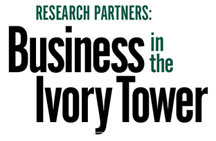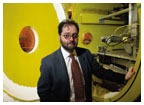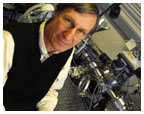Have an opinion about this issue of PAW? Please take a minute to click here and fill out our online questionnaire. It’s an easy way to let the editors know what you like and dislike, and how you think PAW might do better. |
February 23, 2005: Features

As industry increases funding of University research,
faculty members strive to maintain independence
By Brett Tomlinson
Tucked away in a remote corner of the Engineering Quadrangle, Princeton’s Electric Propulsion and Plasma Dynamics Laboratory seems to be a world of its own. High-powered plasma thrusters, using lithium and barium as propellants, accelerate through the simulated vacuum of outer space in two-meter-wide fiberglass cylinders. As mechanical and aerospace engineering professor Edgar Choueiri *91 weaves his way through the lab, he explains more than a half-dozen experiments aimed at creating more efficient rockets to explore distant planets.
“This field used to be science fiction 15 or 20 years ago,” says Choueiri, the lab’s director. “Now it’s a multimillion-dollar industry.”
Plasma rockets, which use far less propellant than their combustion-powered counterparts, apply electricity to a gas to generate plasma, which is then propelled from the thruster. Less propellant means less weight to lift into space, a major cost-saver in long missions.
Industry connection: Research by engineering professor Edgar Choueiri *91 could lead to plasma rockets that would explore distant planets more efficiently and cheaply. Funders of his work have included aerospace companies Honeywell and Aerojet. (photographs by Ricardo Barros)
University watchdog: Professor Will Happer *64, chairman of Princeton’s University Research Board, scrutinizes industry-sponsored proposals to make sure that they have academic value.
Success story: Professor Stephen Forrest’s work on organic light-emitting devices led to a joint venture with AT&T to demonstrate the technology’s possible use for video displays in mobile phones. |
As NASA and the U.S. Air Force began to support more research on plasma thrusters in recent years, universities responded with valuable fundamental work. Industry added its expertise in development and testing, bringing new technologies to life. The large majority of Choueiri’s research funding still comes from government sources — in the last six months, he has landed two major NASA-funded projects — but in recent years he has collaborated with several aerospace companies, including Honeywell and Aerojet. His most recent project includes a proposed testing phase, not yet funded, that would be carried out by Boeing.
“We want to solve problems that lead to publishing Ph.D. theses,” Choueiri says of his lab. “Companies want to solve problems that lead to a product. Luckily, these problems need each other.”
In many fields, from biology to engineering, universities and industry are finding synergies that can lead to discovery and innovation — not to mention profit — and Princeton increasingly has taken advantage of these opportunities in the last decade. The University’s 90-plus industry sponsors provide interesting problems that stimulate professors’ curiosity. Industry-funded research also enables students to apply math and science, often in interdisciplinary projects, helping them to prepare for careers after college. In return, companies that support research gain access to remarkable intellectual capital, cutting-edge laboratories, and a chance to convert ideas into applications.
The goals of industry and the academy, however, have notable differences. Industry seeks profit in the form of proprietary applications. Universities promote discovery, exploration, and a free exchange of ideas. At Princeton, professors and administrators involved with industry collaborations say the University has balanced these competing goals by putting academic values first, and its partners have respected that position. But, as some professors are quick to note, that delicate balance will pose ongoing challenges as Princeton continues to find its place in the world of industry partnerships.
As the executive director of Cisco Systems’ Advanced Internet Initiatives Division, Steve Wolff *61 initiates research projects with universities, exploring cutting-edge areas of Internet development. Cisco’s motivation for working with universities is simple, Wolff says: “That’s where the smart people are.” To find a person with the skills required to solve a problem, funding university research is often the most cost-effective option, even if it means sacrificing direct control of the project, he says.
That was not always the case. Forty years ago, America’s largest corporations had their “smart people” on staff, in extensive industrial research labs. AT&T, IBM, RCA, General Motors, and a handful of other giants stayed in the forefront of technology by supporting basic research in-house, and the system generated such notable innovations as the transistor, as well as significant advances in computers, lasers, television, and other technologies. “Industry then was a lot more like universities,” says Will Happer *64, the Cyrus Fogg Brackett Professor of Physics. “If you went to one of these industrial labs, you could hardly tell the difference from walking down the hall of our engineering school or physics department.”
There was one significant distinction. At industrial labs, new ideas belonged to the company, and the company turned the best research into new products. At universities, patents filed by professors with federally funded projects belonged to the government, and most patents stagnated at the bottom of the development pipeline. In 1980, Congress passed the Bayh-Dole Act, giving universities and businesses operating with federal contracts patent and licensing rights for inventions developed in the lab, and the new opportunities for technology transfer spurred an expansion of partnerships between industry and universities. As industrial labs began to shrink and limit their focus to more practical research, links with colleges continued to grow.
With encouragement and some financial support from the state of New Jersey, the University became more involved with the local scientific community in the mid-1980s. Individual professors found industry partners with help through University-sponsored and state-supported centers, such as the Center for Photonics and Optoelectronic Materials (POEM) and the Princeton Materials Institute (PMI), which recently merged to form the Princeton Institute for the Science and Technology of Materials (PRISM). By 2003—2004, Princeton’s industry sponsors, ranging from small businesses to global corporations, were contributing about $10 million, or 9 percent of the University’s overall research budget, according to the Office of Research and Project Administration.
Joseph Montemarano, PRISM’s industrial liaison, points to professor Stephen Forrest’s work with organic light-emitting devices as one success story that helped encourage more projects with industry partners. Forrest, an electrical engineering professor, worked with the Universal Display Corp., a small company in Ewing, N.J., that initially funded $2 million in research. The project led to a joint venture with AT&T to demonstrate the feasibility of the technology for video displays in mobile phones, and over a 10-year period, Universal Display’s commitment grew to a total of $15 million.
While the industry funding was remarkable, it was the project’s scientific output that turned heads. What seemed to be a laboratory curiosity was suddenly being considered for a range of real-world applications, from laptop computers to handheld electronics. Forrest’s papers explaining the technology were being published in the journal Nature. “Essentially, we proved the skeptics wrong,” Montemarano says. “You can do very high-quality research in areas that have applications that are important to society.”
Government sources still fund 75 percent of research at the University, but relationships with industry have value when applying for some federal grants. As Montemarano says, “Having industrial contacts and entities that you have partnered with successfully is important for getting a sense that this technology has a life beyond just what’s going to be published.”
While proponents say interaction with industry makes university research more focused, others in the academy are uncomfortable with corporations on campus. As former Harvard president Derek Bok wrote in his 2003 book Universities in the Marketplace, published by Princeton University Press, the worst fears about corporate funding have not materialized but some negative developments have, including secrecy in the lab, conflicts of interest, and a few instances in which corporations have tried to influence clinical results.
Of those issues, secrecy is the one that seems to concern Princeton professors most. The standard procedure is to get assurances, before a project starts, that the corporate partner will not stall publication of research results. Waiting a week to finish a patent filing can be tolerated; delaying a Ph.D. thesis for six months cannot. The exchange of ideas is a crucial part of research. “The bottom line of science is that we build on everything,” says Lynn Enquist, chairman of the molecular biology department. “If you can’t exchange information, then you’re not fueling the scientific enterprise.”
Another fear is that industry will play a role in setting university research agendas. At Princeton, the University Research Board provides the first line of defense against that pitfall, scrutinizing proposals and making sure industry-sponsored projects have academic value. Happer, the board chairman and a veteran of industry-sponsored research, watches specifically for “job-shop” projects, where a research problem is product-directed. “We don’t encourage that kind of work at the University,” he says. In addition to the initial approval process, research is evaluated on completion when professors face reviewers and editorial boards to get their work published in top journals. “To me, that’s a measure of success,” Happer says. “You can’t forge that.”
When the School of Engineering and Applied Science, which houses many of Princeton’s industry collaborations, examined its approach to industry links in a December 2003 strategic planning session, the conversation centered on why the University should interact with industry. Dean Maria Klawe recalls two primary reasons: to ensure that the work of Princeton engineers is in tune with the real world (“since engineering is supposed to be about applying mathematics and science to solve real problems,” she says), and to make an impact on the education of students. The potential for financial rewards, Klawe says, ran a distant third.
But the financial side of industry collaboration does affect a university’s reputation. In a 1997 survey of American colleges, Princeton ranked 47th in overall technical strength, based on calculations related to its patent output and licensing income. Last year, in a report in Technology Review, published by the Massachusetts Institute of Technology, Princeton vaulted to sixth in technological strength, using the same criteria as the 1997 report. The University was rated particularly strong in the “current impact index,” a measure of how frequently an institution’s patents are cited, relative to all U.S. patents.
In 2003—04, Princeton filed 98 U.S. patent applications and had 27 patents issued, an output that pales in comparison to the hundreds of patents issued to universities such as the University of California at Berkeley, MIT, and Stanford. Princeton professors say they seek quality over quantity, with industry interactions that take many forms. They can span several departments, like the Carbon Mitigation Initiative, a 10-year, $20 million project sponsored by British Petroleum and the Ford Motor Co. that includes more than 50 researchers working to find sustainable solutions to global carbon and climate problems (see sidebar).
In other cases, industry partnerships are limited to one lab or one faculty member. For example, Claire Gmachl, an associate professor of electrical engineering, works with several corporate partners in her research with quantum cascade lasers, which produce a specific wavelength or color of invisible light used to detect gases that absorb the light. The technology has applications in breath analysis, pollution monitoring, and counter-terrorism, and Gmachl collaborates with semiconductor manufacturers, sensor developers, and medical-equipment companies. Professors with innovative research may also take a high-risk, high-reward approach, cutting out the middleman by purchasing the licenses to their discoveries from the University and creating their own companies. Professor Stephen Chou’s Nanonex Corp., which specializes in nano-imprint lithography (engraving microscopic patterns for
electronic circuits) is one recent example of a faculty startup.
Some professors venture off campus to consult for companies, but the amount of time permitted for consulting is limited by the University. Enquist says that for many in the molecular biology department, consulting provides an important glimpse of biotechnology and pharmaceuticals. Some people find it “an integral part of their intellectual development,” Enquist says. “It gives them a better sense of how their work fits in with the research continuum.”
Consulting occasionally leads to more direct relationships. One of Princeton’s recent success stories, the development of the cancer drug Alimta, began with professor emeritus Edward Taylor’s consulting relationship with Eli Lilly and Co. After reviewing research for Lilly over a period of several years, Taylor partnered with company researchers in the 1980s to discover the molecule now contained in Alimta, an antitumor agent used to fight an asbestos-related lung cancer. Shortly after the drug earned approval from the Food and Drug Administration in February 2004, Taylor said that the project added another dimension to an already rewarding career. “Chemistry is fun,” he said at the time. “To have it apply to something that impinges so clearly on human health is an unexpected bonus.”
To most at Princeton, patent income is also viewed that way — as a bonus — because patents often take years to reach fruition. The molecule in Alimta, for instance, was patented more than a decade before its use was approved by the FDA. In 2003–04, the University’s Office of Technology Licensing and Intellectual Property distributed $315,000 to inventors of the Princeton technologies that earned licensing fees or royalties, and an additional $110,000 to the inventors’ departments. According to Happer, who patented a technology for magnetically imaging human lungs that is now owned by General Electric, the median range for an inventor’s income is usually between a “few thousand dollars and a few tens of thousands,” but major breakthroughs like Alimta can generate more. Companies may also pay consulting fees to professors with inventions in development. Last year, the total income for Princeton’s licensing office, including reimbursed legal fees, was less than $3 million.
At some major research universities, royalty revenues alone reach tens of millions of dollars annually, and industry projects and spin-off companies are the norm — if you do not have a patent in development at a major company, you’re not doing your job as a professor. “I don’t think we’ll ever be like that,” Klawe says. “I think we’ll have a mix of people who are happily involved in industrial collaboration, as well as doing basic research, and we’ll have a mix of people who are not involved in collaborating with industry.”
In some ways, Princeton simply lacks certain advantages, such as location and size. The research-and-development-
oriented area of central New Jersey does not match up with hotbeds of entrepreneurship like California’s Silicon Valley or the Massachusetts Route 128 corridor, and Princeton is significantly smaller than most major research institutions, both in student enrollment and faculty size. But a university’s relationship with industry is also a reflection of the institution’s culture. Is Princeton erring on the side of caution and not maximizing its partnership potential?
For Forrest, one of the Princeton’s staunchest advocates of industry collaboration, balance is important: A leading university must excel in both the fundamental and applied aspects of science. Working with industry is not for everyone, Forrest says, but there are professors at Princeton who would like to work with industry and do not know how to get involved. In that regard, he says the University has room for improvement.
Instead of waiting to see what its peer institutions do, Forrest would like to see the University be more proactive, encouraging links with industry and helping professors solve issues that naturally arise in partnerships.
“If Princeton really wants to come out of this decade in a preeminent
position in science and technology,” Forrest says, “it can’t
lead from the rear.” ![]()
Brett Tomlinson is an associate editor at PAW.




